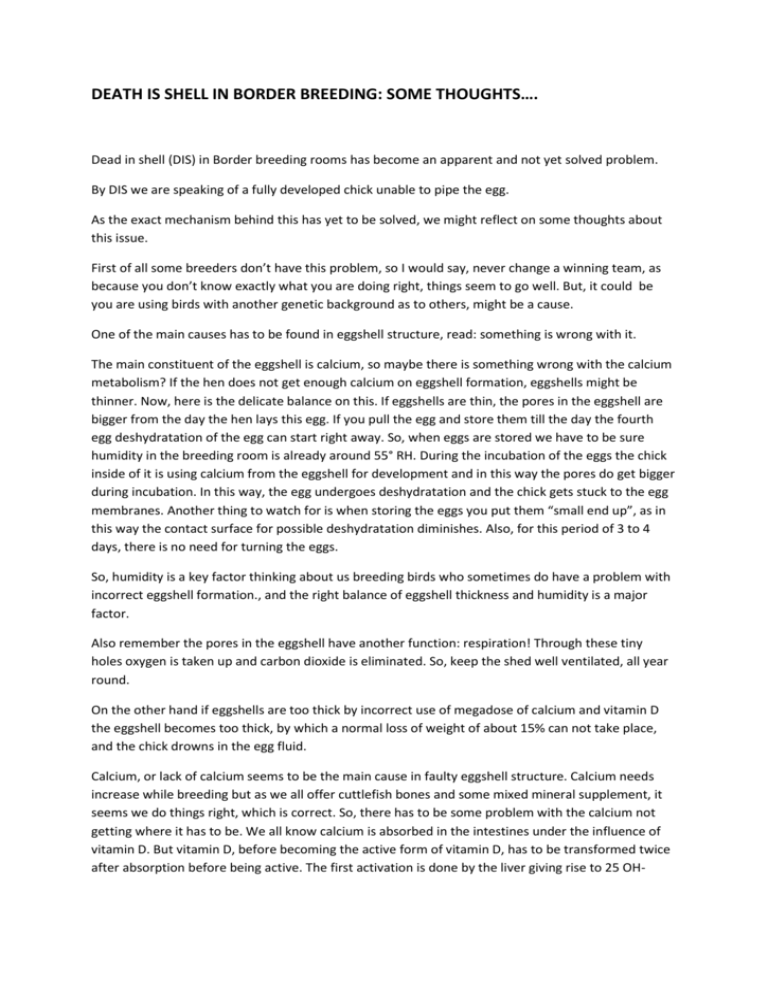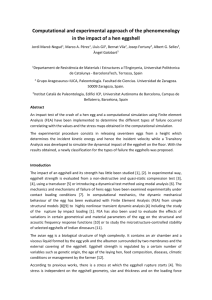some thoughts…. - The Border Convention
advertisement

DEATH IS SHELL IN BORDER BREEDING: SOME THOUGHTS…. Dead in shell (DIS) in Border breeding rooms has become an apparent and not yet solved problem. By DIS we are speaking of a fully developed chick unable to pipe the egg. As the exact mechanism behind this has yet to be solved, we might reflect on some thoughts about this issue. First of all some breeders don’t have this problem, so I would say, never change a winning team, as because you don’t know exactly what you are doing right, things seem to go well. But, it could be you are using birds with another genetic background as to others, might be a cause. One of the main causes has to be found in eggshell structure, read: something is wrong with it. The main constituent of the eggshell is calcium, so maybe there is something wrong with the calcium metabolism? If the hen does not get enough calcium on eggshell formation, eggshells might be thinner. Now, here is the delicate balance on this. If eggshells are thin, the pores in the eggshell are bigger from the day the hen lays this egg. If you pull the egg and store them till the day the fourth egg deshydratation of the egg can start right away. So, when eggs are stored we have to be sure humidity in the breeding room is already around 55° RH. During the incubation of the eggs the chick inside of it is using calcium from the eggshell for development and in this way the pores do get bigger during incubation. In this way, the egg undergoes deshydratation and the chick gets stuck to the egg membranes. Another thing to watch for is when storing the eggs you put them “small end up”, as in this way the contact surface for possible deshydratation diminishes. Also, for this period of 3 to 4 days, there is no need for turning the eggs. So, humidity is a key factor thinking about us breeding birds who sometimes do have a problem with incorrect eggshell formation., and the right balance of eggshell thickness and humidity is a major factor. Also remember the pores in the eggshell have another function: respiration! Through these tiny holes oxygen is taken up and carbon dioxide is eliminated. So, keep the shed well ventilated, all year round. On the other hand if eggshells are too thick by incorrect use of megadose of calcium and vitamin D the eggshell becomes too thick, by which a normal loss of weight of about 15% can not take place, and the chick drowns in the egg fluid. Calcium, or lack of calcium seems to be the main cause in faulty eggshell structure. Calcium needs increase while breeding but as we all offer cuttlefish bones and some mixed mineral supplement, it seems we do things right, which is correct. So, there has to be some problem with the calcium not getting where it has to be. We all know calcium is absorbed in the intestines under the influence of vitamin D. But vitamin D, before becoming the active form of vitamin D, has to be transformed twice after absorption before being active. The first activation is done by the liver giving rise to 25 OH- Vitamin D, after which a second activation occurs in the kidneys giving the active form of vitamin D, the 1-25 OH Vitamin D3. So, if thinking about this, there might be a problem in the liver , this can be due to infectious disease (latent atoxoplasmosis), nutritious (fatty liver syndrome) or genetic, by which I mean breeding birds who have a genetic defect of the enzyme in the liver. Another cause could be the kidneys, if kidney function is impaired enzymatic function decreases, for example by giving too much calcium in the drinking water, or , again, some genetic enzymatic inherited problem of kidney enzyme activity. Calcium being given in the drinking water is one of the things often being done by fanciers with success. By doing this the route of vitamin D dependant calcium absorption is being bypassed and the calcium is absorbed through passive diffusion in the intestines, no need for vitamin D! But, if overdone, as already mentioned can lead to kidney stones and impaired kidney function with impaired vitamin D formation. Another aspect is the chick, when piping the egg needs calcium for muscle contraction when piping the egg and turning around on itself. Also this chick, albeit possible getting the calcium needed from the eggshell, also needs vitamin D. Vitamin D is being stored in the egg as the 25 OH vitamin D, and this is activated by the chick when calcium is needed for piping. So, even if you get good eggshell quality by giving calcium supplements, it might be possible you have not met the chicks vitamin D levels in the egg. In poultry breeding 25 OH vitamin D is being used as well as for getting better eggshells and as we know by now, the necessary 25 OH vitamin D3 levels stored in the egg, so the chick can activate this when it needs calcium for muscle contraction. Also of importance is the energy source the chick uses when piping the egg, which is mainly energy from fatty acids. It has been shown when supplementing the hens food with the necessary antioxidants, these fatty acids are not broken down during the incubation period and the chick can use them as the main energy source when piping. In these antioxidants we think about vitamin A, vitamin C, selenium, vitamin E, carotenes and glutathione, as we can find them in fruits, vegetables and spirulina. One can also increase the amount of “good” fatty acids in the egg by supplementing the hens diet with some brewery by products which do contain linolic acid. Infectious factors have been mentioned by some, like Mycoplasm infections, but till today nobody has been giving feedback the problem has been solved by a prebreeding cure of tylosin or tiamulin. I am sure many have been trying this, so reports should give us some more insight in this. So, by now we have: - Interaction between eggshell thickness and ambient humidity. Calcium absorption: vitamin D dependant and not vitamin D dependant. Energy source for the chick when piping, fatty acids, and the protective role of antioxidants in this. Calcium and 25 OH needs of the piping chick for muscle action. Infectious cause? No positive reports on this yet. Genetic errors in metabolism in some strains? For as it is by now, a single main cause of DIS has not yet been found, it is my opinion the causes are multifactorial and the way to solve this problem is by reporting as well some positive effects of some action being taken, as well as the opposite, we all can learn from both sides of the story. I know the Border Convention is taking all this under its wings, but I think more feedback is needed. Dr Jan Vanderborght MD Belgium dr.vanderborght@gmail.com








